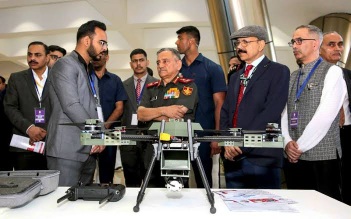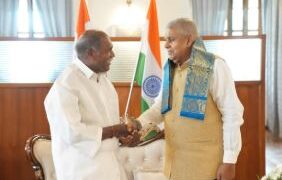The history of military relations between India and Pakistan has been full of events of long struggle, mistrust and conflict. The conflict, which began immediately after partition in 1947, has so far taken the form of four traditional wars, several border clashes and continuous terrorist activities. Although the nature of war is changing in the 21st century-now the deployment of soldiers on the borders is not decisive, but also playing a decisive role, but also a decisive role. The military confrontation between India and Pakistan in early 2025, which was in response to the terrorist attack in Pahalgam, presents a live example of this changed war-review.
Pakistan’s military policy has long been operating with the help of ‘nuclear umbrella’ and dependence on China. Pakistan’s defense system has a highly presence of weapons and military equipment provided by China. JF-17 Thunder such as Fighter Aircraft, Wing Longs like Drone, Achketu-16 (HQ-16) and LY-80 (LY-80) like air defense systems (LY-80), AIR Defense Systems, and many other missiles and many other missiles-all the Chinese. Become part of military structure. China sells these weapons with slogans of ‘low cost, high lethality’, but their effectiveness in the practical war field has been repeatedly questioned. Technically these weapons do not rest parallel to developed countries. Recently, reports of malfunctions in the radar system of JF-17 (JF-17) aircraft sent by Pakistan Air Force, and missiles left by them missed the target. This fact highlights that not only the number in war, but the quality, reliability and trained operations are more important.
Although in recent years he has also turned to the Turks, especially in the Drone Warfare System. Her military collaboration with the Turkas added Bayerkar TB2 and recently developed Sogren (Sogren) Tactical Looting Drone to her fleet. This cooperation has also been inspired by religious-political equations. The sogren drone is a light, high speed and low -flying drone, which is especially designed for the identification of the surveillance in urban and mountainous areas and the identification of the exact goals. This drone can also carry limited explosives with it, which not only monitoring but also in the category of ‘Loitering Munition’ i.e. suicide drone. India thwarted many admission efforts of such drones in Punjab and Jammu region and also succeeded in killing some of them. The Ministry of Defense, while certifying these incidents, said that the origin of these drones is based on Turkish Technology.
In response to this, India gave multi-layered response. First of all, India further strengthened its anti-drain warfare capability. Systems such as Smart Jamming Technology and BEL – Bharat Electronics Limited by DRDO are now active on India’s borders. With the help of these systems, India inactivated Turkish drones like Sogren and Bayraktar in the air. In addition, India has made a surgical strands (HALE-HALE-High Altitude Long Enduration) Drone Launched Slights (HALE-HALE-High Altitude Long Enduration) with the help of drone and surgical strands (HALE-HALE-High Altitude Long Enduration) Drone Laon (HALE-HERON TP). Destroy them through Strike).
In contrast, India has preferred self-reeliance, multilateral technical partnerships and priority to precise strategy in their defense policy. India has equipped its Air Force with state-of-the-art fighter aircraft such as Sukhoi-30 MKI and Rafale received from France, including long distance air-to-air-to-air-to-air-to-air-to-air system (meteor), and complex electronic warfare system like AESA radar (AESA Radar), Meteor (Meteor). Warfare Systems). Not only this, India carried out highly accurate attacks using MQ-9 Reaper and Heron Drone in recent conflicts, which succeeded in destroying terrorist bases. In these campaigns, India also used the Brahmos supersonic cruise missile, which is far ahead of any of Pakistan’s missile system in both speed and accuracy.
One important thing is that India targeted not only the physical goals in these attacks, but also the communication system of Pakistan, radar network and drone control mechanism. The Electronic Warfare Units of the DRDO and the Indian Air Force blocked the China-made communication system of Pakistan, making their drones become directionless and failed to return. It is a clear indication that war is now not only limited to land, water or air, but also being fought in cyber and electronic domain.
The 2025 military conflict made it clear that South Asia is no longer a region of traditional conflicts, but it has become a complex lambling of global defense supplies, diplomatic policies, and technical dominations. Countries like China and Turkas are no longer limited to selling weapons, but they are also shaping Pakistan’s strategic view.
Nevertheless, the most important conclusion of this struggle is that India not only surrendered against the joint efforts of these external powers, but was successful in achieving decisive strategic edge. India’s self-sufficient defense policy-including indigenous weapon production, judicious use of international defense partnerships (Judicious Use of International Defense Partnerships), and Multi-Level Military Training (Multi-Level Military Training)-has been proved now. Not of technology, intelligence and strategy have become a game of strategy.
Wrackage recovery was not a symbolic phenomenon, but it was a solid technical challenge against India’s security sovereignty, which India completely failed. This is a proof of India’s foresight which is no longer defensive, but also a fractive and decisive. In the coming years, India will not only have to be the best in military technology, but it will also have to ensure that countries like Pakistan can not threaten regional peace by ignoring international military standards with the help of external powers. This requires this a trinity of strategic Expertise, diplomatic firmness and strategic self-reeliance trinity-and this conflict of 2025 is proof that India leads to that route.
Harsh Pandey is a PhD scholar at the School of International Studies, JNU, New Delhi.






